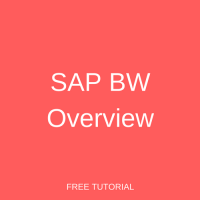 Welcome to the tutorial with SAP BW Overview. It is part of our free SAP BW course. In this tutorial, let’s get to understand the basics of SAP BW by studying a general SAP BW overview.
Welcome to the tutorial with SAP BW Overview. It is part of our free SAP BW course. In this tutorial, let’s get to understand the basics of SAP BW by studying a general SAP BW overview.
SAP BW Overview
SAP BW stands for SAP Business Warehouse. It is primarily used to integrate data from various sources, transform and consolidate data, perform data cleansing, and store the cleansed data.
Generally speaking, data warehousing is defined as the process of data extraction, transformation, and loading of data to the warehouse and the access of the data by end users and applications. It is very useful in providing business intelligence through analytics that is based on data stored within it, and helps companies in making management decisions from time to time. Data warehousing maintains a single data source that is used by multiple applications across functions, and/or locations, depending on the common interface requirements, and puts it in perspective depending on the business need. The information generated through this mechanism is generally reliable, and helpful in studying past trends or making a forecast. Additionally, data warehousing simplifies integration with various different applications based on technology, while also improving the speed with which information is processed and made available.
The main five challenges in the world of Data Warehousing are considered to be:
- Quality of data entry
- Collecting and storing data
- Finding data when you need it
- Turning data into useful information
- Differentiating what does and doesn’t need to be secure, and keeping it safe
SAP BW Architecture
Let’s take a look at the architecture of SAP BW. SAP BW basically has a 3-tier architecture:
- Database Server
- Application Server
- Presentation Server
A close look at each of these tiers will help you understand what SAP BW is all about.
Database Server: This is the place where data is stored physically. It includes DSO (DataStore Objects), PSA (Persistent Staging Area), Infocubes, etc.
Application Server: It is based on Online Analytical Processing (OLAP) processor. OLAP basically does multidimensional data analysis. It is basically used to get the data stored in database server.
Presentation Server: It manages the reporting and data access.
It begins with access mechanisms for retrieving data from mixed operational data resources. That data is replicated through a transformation model and stored in the data warehouse (DW). The description of data elements in the DW and in the data sources and the conversion rules which connect them, are referred as ‘metadata’. Metadata is the means by which the end-users find and recognize the data in the warehouse. The data conversion and movement procedures are performed whenever a revise to the warehouse data is preferred. Various parts of the warehouse may need updates at different times, some at regular periods, for example, weekly, monthly, and some on specified dates.
Following are the steps involved in a typical SAP BW flow:
- Extract data from source systems (SAP or non-SAP).
- Stage the data in a Persistent Staging Area (PSA). Use this to hold all the data extracted from various sources.
- Clean, load and store the data in Data Store Object (DSO).
- View the data by the various dimensions in Infocube.
- Make the data available to Business Explorer by OLAP processor.
- Make the data available to Open Hubs, SAP/non-SAP systems, etc. as per the business need.
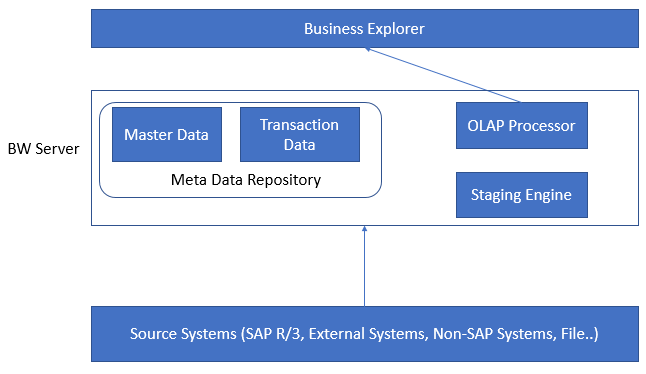
ETL (Extract/Transform/Load) Processes
As a next step in our SAP BW overview, let’s talk about ETL (Extract/Transform/Load) processes in BW. The picture below shows a graphical illustration of the BW Data Flow:

Data Extraction
SAP BW allows you to extract data from various sources. SAP BW can function as a target system for transferring data from other source systems. It can also function as a source system for sending data to other BI targets.
The following are the different SAP BW Source Systems:
- SAP Systems
- BI systems
- Flat files
- Database management systems
- Relational/Multidimensional sources
- Web Services
- Non-SAP systems
Now, let’s go to SAP system. Here, you should go to the transaction RSA1 to open the Data Warehousing Workbench.
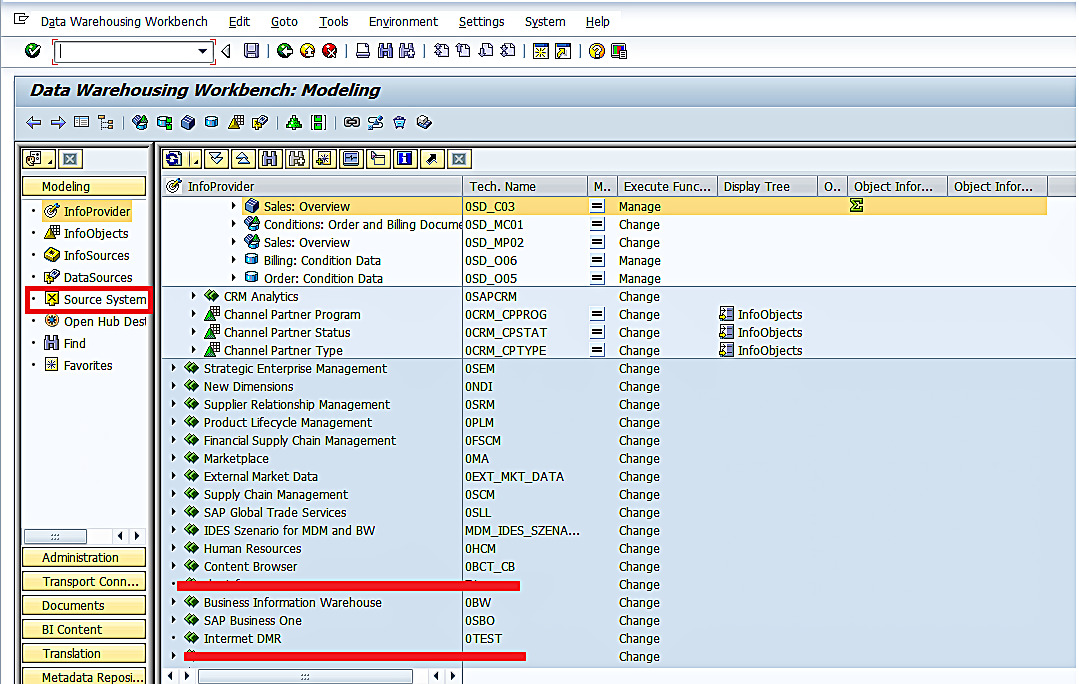
Click on “Source Systems” highlighted in the above screen to define/view the source systems.

You can differentiate between source systems based on the type of the data source. There are two types of data sources:
- Data Sources for transaction data
- Data Sources for master data
Data Sources for master data are further classified into:
- Data Sources for hierarchies
- Data Sources for text
- Data Sources for attributes
Data Transformation
In SAP BW, transformation is used to convert a source field format to the corresponding target field format. You have to specify source and targets of the transformation while creating it (screenshot is given below).
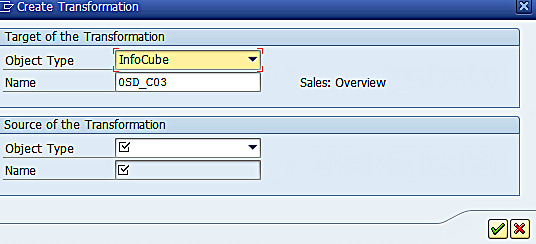
Every transformation in SAP BW must have a minimum of one rule. There are various rule types that are available. Below is the list of rule types:
- Direct Assignment
- Constant
- Formula
- Initial
- Read Master Data
- Routine
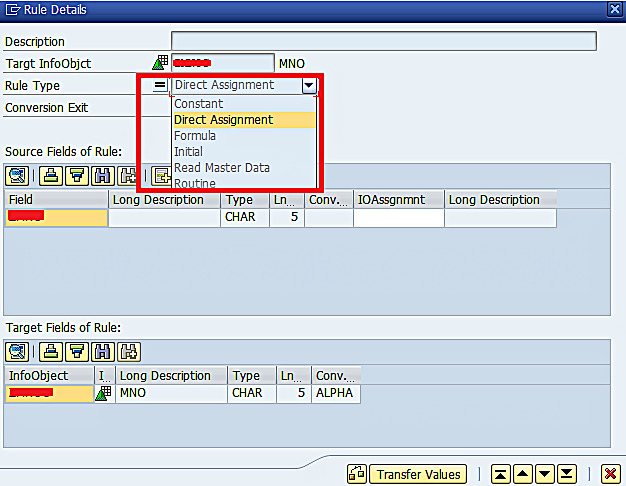
Data Loading
InfoPackage: InfoPackage helps you to load data from source system into the data source structure of SAP BW.
An InfoPackage primarily has the settings of when to load and how to load the data from source system to a Data Source or PSA.
Data Transfer Process (DTP): It is used to transfer data between persistent/non-persistent objects within BW. InfoPackage just loads the data from a source system to PSA. It is DTP that is used to load data thereafter. Below are the uses of DTP:
- Load data from PSA to InfoProvider(s)
- Data Transfer from one InfoProvider to another in SAP BW
- Distribute data to targets that are outside of SAP BW such as OpenHubs
Querying the Warehouse
Finally, the last aspect that we are going to discuss in SAP BW overview is data retrieval from the warehouse. Retrieving information from SAP BW is achieved through SAP BEx tools. SAP BEx tools allow you to perform reporting. You can create, find, run, view, format, manage, schedule, and precalculate the reports. The BEx tools that are primarily used for reporting are BEx Query Designer, BEx Analyzer, BEx Web Analyzer, BEx Report Designer, BEx Web Application Designer (WAD), and BEx Broadcaster and Information Broadcasting.
Conclusion
Let’s conclude our SAP BW overview. The problems such as non-standard processes, manual or partially automated processes, multiple non-integrated systems, duplication of data entry/processing effort have been increasingly becoming common across enterprises. Enterprises should therefore aim towards addressing the issues and challenges being faced by implementing Data Warehouse to be able to move ahead on a growth journey.
Implementing SAP BW resulted in many advantages to many organizations. For instance, ERGO Austria, one of the five largest insurance groups in Austria, implemented SAP BW solution which helped it to meet its diverse requirements. The group Data Warehouse solution implemented through SAP BW helped the client to perform insurance reporting under one umbrella.
—
Did you like this tutorial? Have any questions or comments? We would love to hear your feedback in the comments section below. It’d be a big help for us, and hopefully it’s something we can address for you in improvement of our free SAP BW tutorials.
Navigation Links
Go to next lesson: SAP BEx Tools Overview
Go to previous lesson: What is SAP BW
Go to overview of the course: SAP BW Training

Why is there no mention of transactions SQ02, SQ01, and SQ00 for the classic query and reporting solutions? I believe they are simpler, quicker, more flexible, and far superior to the BEx tools.
There is no mention of SQ01, SQ02 and SQ00 because they are part of SAP ECC but this is a tutorial about BW. Also, they cannot be superior to the BEx tools because if it was the case, SAP wouldn’t need to create SAP BW at all.
These SQXX transactions are available in BW as well as SAP ECC. The need for the BW arose because the reporting needs (and CPU time) were interfering with the manufacturing/production needs in the SAP system.
True, they can also be found in BW. I didn’t know that they are also available in BW since I am not a BI consultant. However, they are still not superior to BEx tools in terms of functionality. The only area where they excel is real-time reporting.